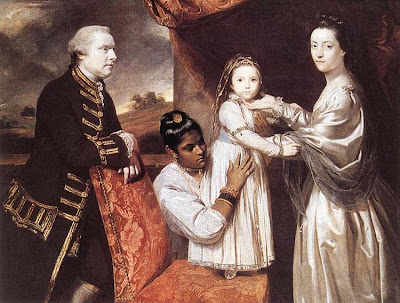Sir Robert Clive with wife, daughter and local help, 1765, Joshua Reynolds
The painting Sir Robert Clive with wife, daughter and local help offers many recurring themes of colonialism. It gives viewers a rare inside look into the minds of colonists. The painting exemplifies the deluded thoughts of the British, who assumed they were superior to the Indians. To illustrate this point all of the British people tower over the Indian woman, who is on her knees. The Indian woman is on the floor, which further indicates her low social status in the eyes of the British. Even the small child is standing on a chair, as if to exaggerate her importance. This simultaneously emphasizes the Indian women’s inferiority. The Indian woman is richly dressed. She has bangles and rings on her wrists and hands. She also wears a gold necklace. Her garb suggests that she used to be of the wealthy upper class. This represents how the British demolished the caste system. The wealthy lost all authority, and were demoted to servants work. This painting accurately displays the effects of British colonialism.
Colonialism in India was a brutal and destructive affair, which incapacitated India. This is partially the reason why today India is still trying to catch up with the developed world. The British were the primary colonists of India. They colonized India in a unique way. The British government used the private East India Company to invade India. This quickly sparked a bout for control. The wealthy lost their position as the elite of India. The poor became poorer; many died or were killed by the British. Not only did the British take control of India. They took it upon themselves to abuse and enslave the natives. The British massacred hundreds of starving Indians, who were incapable of completing endless chores. The East India Company operated so grotesquely, that even British people began to denounce the company as a “bloodstained monopoly”.
In 1775 the British won the Battle of Plassey. Robert Clive played a major role This gave them complete control over the government of Bengal. In turn this fortified the British presence in India. This decisive battle convinced the British to expand their control over India, and push other countries out of India. This battle caused the East India Company to become involved in politics. The company began to rely on Bengali taxpayers for its source of revenue. Subsequently the focus of the company shifted from commerce to revenue. The company collected Bengali taxes, but they were never used to support the Bengali government. The taxes were used to pay government officials and provide parliament with funds. Considerable amount of Indian taxes were used to provide gifts for members of the British parliament. The British also used Bengali taxes to strengthen their military. This led to the British rapidly expanding their empire to include all of India. The British abused their power, and exploited Indian taxes to increase the company’s revenue. Many British were disgusted by the East India Company’s behavior. The economist and moral philosopher Adam Smith labeled the company as “useless and responsible for grotesque massacres in Bengal”. Adam Smith’s words exemplify the barbaric manner in which East India Company operated.
"The East India Company ." The Economist, December 17, 2011.
Subscribe to:
Post Comments (Atom)

No comments:
Post a Comment